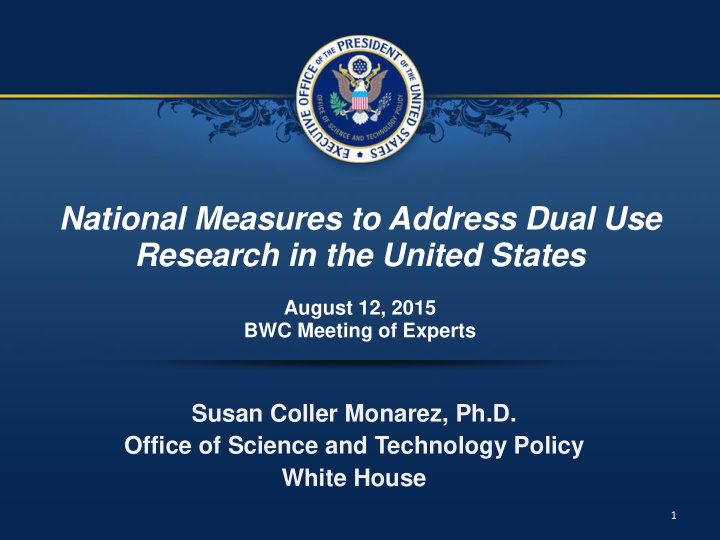



National Measures to Address Dual Use Research in the United States August 12, 2015 BWC Meeting of Experts Susan Coller Monarez, Ph.D. Office of Science and Technology Policy White House 1
Working Together is Essential 2
Importance of Life Sciences Research ● Life Sciences Research Supports: Biotechnology and Public Health Advances Improvements in Agriculture Safety and Quality of Food Supply Environmental Quality Strong National Security and Economy 3
United States Government Definitions • Dual use research (DUR): research conducted for legitimate purposes that generates knowledge, information, technologies, and/or products that can be utilized both for benevolent and harmful purposes. • Dual Use Research of Concern (DURC): research that, based on current understanding, can be reasonably anticipated to provide knowledge, information, products, or technologies that could be directly misapplied to pose a significant threat with broad potential consequences to public health and safety, agricultural crops and other plants, animals, the environment, material, or national security. 4
Dual Use Research of Concern 2011 2001 2005 2014 2002 5
Purpose of DURC Policies • Aim to preserve the benefits of life sciences research while minimizing the risk of misuse of the knowledge, information, products, or technologies provided by such research • Complement existing regulations and policies governing the safe and secure use of pathogens and toxins 6
Dual Use Research of Concern ● USG Policy for Oversight of Life Sciences Dual Use Research of Concern (March 29, 2012) ● HHS Framework for Highly Pathogenic Avian Influenza Research (February 21, 2013) ● USG Policy for Institutional Oversight of Life Sciences Dual Use Research of Concern (September 24, 2014) ● USG Gain-of-Function Policy (under development) 7
Research Subject to the Policies: 15 Agents ● Avian influenza virus (highly pathogenic) ● Bacillus anthracis ● Botulinum neurotoxin (any quantity) ● Burkolderia mallei ● Burkholderia pseudomallei ● Ebola virus ● Foot-and-mouth disease virus ● Francisella tularensis ● Marburg virus ● Reconstructed 1918 influenza virus ● Rinderpest virus ● Toxin-producing strains of Clostridium botulinum ● Variola major virus ● Yersinia pestis 8
Research Subject to the Policies: 7 Experimental Effects ● Enhances the harmful consequences of the agent or toxin ● Disrupts immunity or the effectiveness of an immunization against the agent or toxin without clinical and/or agricultural justification ● Confers to the agent or toxin resistance to clinically and/or agriculturally useful prophylactic or therapeutic interventions against that agent or toxin or facilitates their ability to evade detection methodologies ● Increases the stability, transmissibility, or the ability to disseminate the agent or toxin ● Alters the host range or tropism of the agent or toxin ● Enhances the susceptibility of a host population to the agent or toxin ● Generates or reconstitutes an eradicated or extinct agent or toxin listed in the policy 9
Research Subject to the Policies: Determination ● If the research with any of the 15 agents involves any of the 7 experimental effects, conduct a risk assessment to determine if it meets the definition of DURC: Research that, based on current understanding, can be reasonably anticipated to provide knowledge, information, products, or technologies that could be directly misapplied to pose a significant threat with broad potential consequences to public health and safety, agricultural crops and other plants, animals, the environment, material, or national security. 10
Re-assessing Gain-of-Function Research ● Recent laboratory incidents prompted a reassessment of the risk/benefit calculus that underpins funding for certain types of gain-of-function studies ● Recent calls from multiple stakeholders for science-based deliberation Cambridge Working Group Scientists for Science European and other efforts ● Highest concern for respiratory pathogens with pandemic potential (MERS, SARS, and influenza) 11
Gain-of-Function Research Deliberative Process On October 17 , 2014, the U.S. • Government announced the launch of a deliberative process to assess the potential risks and benefits associated with gain- of-function studies. • During the deliberative process, the U.S. Government instituted a pause on funding for certain kinds of gain-of-function experiments involving influenza, SARS, and MERS viruses.
Key Voices in the U.S. Gain-of-Function Deliberative Process National Science Advisory Board for Biosecurity (NSABB) Draft a set of recommendations on a conceptual approach to the • evaluation of proposed gain of function studies that will be reviewed by the broader life sciences community • Serve as the official federal advisory body for providing advice on oversight of this area of research to the HHS Secretary United States National Academies of Science • Convene two public conferences to facilitate broad discussion of the issues associated with gain of function research, to include discussion of the NSABB draft recommendations. • Provide summary of public discussions and feedback on the forthcoming NSABB draft recommendations
Estimated Timeline Mid 2015 – Mid 2016 Late 2014 – Early 2015 NSABB NSABB delivers deliberates NSABB considers NSABB periodically NSABB analyzes & final key features National Academies assesses progress & NSABB discusses results → recommendations of study input & advises on reviews preliminary reviews final Develops draft to USG design draft study design results results recommendations Weighing of Risks & Conduct of Study USG GOF Benefits + Study Design Results of Study Risk Assessment + Development of Policy Benefit Assessment Recommendations National Academies National National Academies host Public Symposium Academies to discuss NSABB draft host Public provide recommendations & Symposium to Symposium discuss provide Symposium Summary Summary assessment of GOF research
Resources Available at: www.phe.gov/s3/dualuse Questions about implementing the Policy may be sent to DURC@ostp.gov 15
Thank you 16
Recommend
More recommend